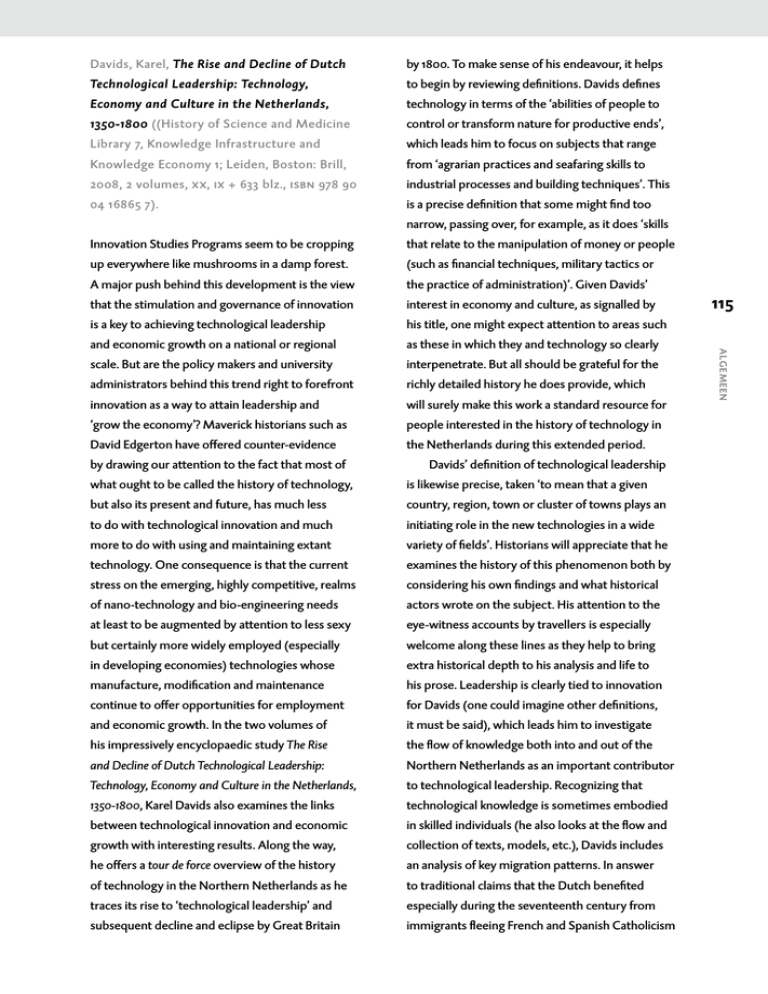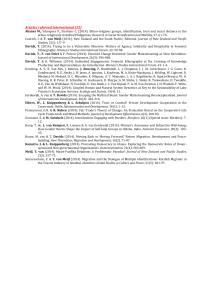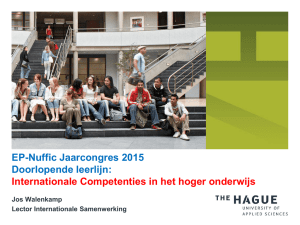A LG EM EEN Davids, Karel, The Rise and Decline of Dutch
advertisement

Davids, Karel, The Rise and Decline of Dutch by 1800. To make sense of his endeavour, it helps Technological Leadership: Technology, to begin by reviewing definitions. Davids defines Economy and Culture in the Netherlands, technology in terms of the ‘abilities of people to 1350-1800 ((History of Science and Medicine control or transform nature for productive ends’, Library 7, Knowledge Infrastructure and which leads him to focus on subjects that range Knowledge Economy 1; Leiden, Boston: Brill, from ‘agrarian practices and seafaring skills to 2008, 2 volumes, xx, ix + 633 blz., isbn 978 90 industrial processes and building techniques’. This 04 16865 7). is a precise definition that some might find too narrow, passing over, for example, as it does ‘skills that relate to the manipulation of money or people up everywhere like mushrooms in a damp forest. (such as financial techniques, military tactics or A major push behind this development is the view the practice of administration)’. Given Davids’ that the stimulation and governance of innovation interest in economy and culture, as signalled by is a key to achieving technological leadership his title, one might expect attention to areas such and economic growth on a national or regional as these in which they and technology so clearly scale. But are the policy makers and university interpenetrate. But all should be grateful for the administrators behind this trend right to forefront richly detailed history he does provide, which innovation as a way to attain leadership and will surely make this work a standard resource for ‘grow the economy’? Maverick historians such as people interested in the history of technology in David Edgerton have offered counter-evidence the Netherlands during this extended period. by drawing our attention to the fact that most of what ought to be called the history of technology, is likewise precise, taken ‘to mean that a given but also its present and future, has much less country, region, town or cluster of towns plays an to do with technological innovation and much initiating role in the new technologies in a wide more to do with using and maintaining extant variety of fields’. Historians will appreciate that he technology. One consequence is that the current examines the history of this phenomenon both by stress on the emerging, highly competitive, realms considering his own findings and what historical of nano-technology and bio-engineering needs actors wrote on the subject. His attention to the at least to be augmented by attention to less sexy eye-witness accounts by travellers is especially but certainly more widely employed (especially welcome along these lines as they help to bring in developing economies) technologies whose extra historical depth to his analysis and life to manufacture, modification and maintenance his prose. Leadership is clearly tied to innovation continue to offer opportunities for employment for Davids (one could imagine other definitions, and economic growth. In the two volumes of it must be said), which leads him to investigate his impressively encyclopaedic study The Rise the flow of knowledge both into and out of the and Decline of Dutch Technological Leadership: Northern Netherlands as an important contributor Technology, Economy and Culture in the Netherlands, to technological leadership. Recognizing that 1350-1800, Karel Davids also examines the links technological knowledge is sometimes embodied between technological innovation and economic in skilled individuals (he also looks at the flow and growth with interesting results. Along the way, collection of texts, models, etc.), Davids includes he offers a tour de force overview of the history an analysis of key migration patterns. In answer of technology in the Northern Netherlands as he to traditional claims that the Dutch benefited traces its rise to ‘technological leadership’ and especially during the seventeenth century from subsequent decline and eclipse by Great Britain immigrants fleeing French and Spanish Catholicism Davids’ definition of technological leadership ­115 algemeen Innovation Studies Programs seem to be cropping recensies (Huguenots, along with Flemish and Sephardic does it mean ultimately to talk about ‘Dutch’ refugees), he shows both that significant levels of technological leadership or ‘British’ industrial technological knowledge entered the Northern superiority, when both rest so firmly on the global Netherlands between the mid-fourteenth century circulation of knowledge, skill, travellers, goods and 1580 – thus prior to the influx of these and trade? (See, for example, Christine MacLeod, immigrants – and that this post 1580 immigration ‘The European Origins of British Technological wave actually coincided with a century that saw a Predominance’, in: L.P. de la Escosura (ed.), decline in the import of knowledge and a rise in its Exceptionalism and Industrialism: Britain and its export. European Rivals 1688-1815 (Cambridge 2004) 111-126; Maxine Berg, ‘In Pursuit of Luxury: Global History More fundamentally, though, Davids wields his evidence to weaken another popularly held and British Consumer Goods in the Eighteenth view. Against those who insist on coupling Century’, Past and Present 182 (2004) 85-142.) One technological innovation with economic growth, hopes that studies like this one by Karel Davids he demonstrates that Dutch leadership followed can help sensitive readers find a salutary balance a somewhat different pattern than that of its between the search for local uniqueness and global economic development. For it was while the Dutch interconnexions. economy was beginning its relative decline during the late seventeenth century that the Northern said about the poor editing job done by Brill Press Netherlands established itself as a technological on a serious study for which they are charging leader. Only in the late eighteenth century did the € 149. Surely the publishers could have hired a Dutch really begin to give way to the English, while copy editor to review a manuscript written by concerns with Dutch technological prowess were a scholar who, after all, was not writing in his still being voiced by well informed Europeans such primary language. The text abounds with awkward as Jean-Antoine Chaptal in the early nineteenth sentences, typographic and spelling errors, poor century. This leaves open, then, the question of punctuation and the like. The author, who has done how to account for what Davids paints as (the a commendable job of marshalling a huge amount Northern Netherlands’) technological leadership of empirical evidence and clearly explicating (in and decline. Here he sides with those such as principle) numerous theoretical positions related Joel Mokyr who call on us to buttress analyses to the topics of technological leadership and of market forces with increased consideration of economic growth, should not be blamed for this cultural and institutional factors. How pluriform situation; it is the publisher’s job to see to it that an is the ambient political system, for example? Do author’s hard work is not marred by such things. socio-cultural organisations and mechanisms exist As the co-editor of the series in which this study to encourage the collection, demonstration and appears, Davids will certainly have much to say to discussion of knowledge? Brill about their current practices. Finally a less pleasurable word needs to be These two volumes have much to teach us about the intricacies of technological development lissa roberts, and the crowded roads and waterways along university of twente which knowledge and opportunities – embodied likewise in people, texts, tools and commodities – travelled to, through and from the Northern Netherlands. Indeed the heaviness of this traffic might give us pause before we launch further into tales of national advance and superiority. What Janssen, Jette, De deugd van broederschap. omdat sommige gilden heel goed voor hun archief Sociaal kapitaal van gildebroeders in de gezorgd hebben, maar andere daarentegen bijna Noord-Brabantse schuttersgilden, 1600-2000 alles hebben weggegooid. De uitslag bevestigt (Dissertatie Tilburg 2009, Bijdragen tot de grotendeels het beeld wat kenners al hadden: geschiedenis van het Zuiden van Nederland. verreweg de meeste leden kwamen uit de plaats Derde reeks 36; Tilburg: Stichting Zuidelijk waar het gilde gevestigd was of uit de directe Historisch Contact, 2009, 330 blz., isbn 978 90 omgeving. Alle leden waren katholiek of gaven 70641 88 7). voor dat te zijn. Zoons volgden hun vader op, maar wel meestal nadat deze was overleden, of Noord-Brabant kent heden ten dage 200 meldden zich als lid aan op aanraden van broers actieve schuttersgilden die met kleurrijke of schoonvaders. Overigens waren de gilden geen kledij, vendelzwaaien en op buitenstaanders besloten clubs en het aandeel van uitheemse leden indruk makende tradities een levend en vaak wisselde in de loop der tijd sterk. gefotografeerd element in de samenleving zijn. Over de geschiedenis van deze gilden, gediscussieerd, maar wel is duidelijk dat de oudste die wel onderscheiden moeten worden van schuttersgilden ontstonden in de steden en ambachtsgilden en religieuze broederschappen, is dat het platteland vanaf de late middeleeuwen sinds 1933 veel gepubliceerd. Vermeldenswaardig is volgde. De meeste gilden in Noord-Brabant zijn het in 1993 verschenen boek van E. van Autenboer na 1550 opgericht. De kern van het takenpakket over de gilden in het hele vroegere hertogdom bestond uit verdediging van het eigen dorp Brabant tussen 1300 en 1800. Het proefschrift van tegen van buiten komend gevaar, bewaking en Jette Janssen (promotoren waren de Tilburgse beveiliging, socialisatie, en deelname aan religieuze hoogleraren A.J. Bijsterveld, P. Nissen en W. plechtigheden zoals processies, uitvaarten en Arts) is niet bedoeld als dé geschiedenis van de bruiloften. Zeer onderscheidend was het schieten schuttersgilden, maar zoomt in op de geschiedenis met voet- of kruisboog of geweer op de vogel. van de leden, de broeders. Centraal staan de Wie de vogel eraf schoot werd koning, wie dat vragen: wie waren zij, waarom werden zij lid en driemaal achtereen voor elkaar kreeg keizer. Of hoe beleefden en realiseerden ze het lidmaatschap de gilden als defensieorganisaties werkelijk iets met als essentiële elementen verwantschap, betekend hebben is nog maar de vraag. De meeste broederschap, traditie, eer en prestige. Het gilden waren te klein om een heel dorp afdoende onderzoek nam bijna negen jaar (2000-2009) in te kunnen beveiligen. Toch organiseerden veel beslag. dorpen in dit door oorlogen geteisterde gebied een nachtwacht bestaande uit volwassen mannen Over de oorsprong van de gilden is veel van Janssens onderzoek is een prosopografie die gewapend met een roer of ander schiettuig van een dubbel gestratificeerde steekproef ’s nachts de ronde maakten. Toen noordelijk uit de leden. De eerste selectie bestond uit 18 Brabant na 1648 voorgoed deel ging uitmaken van gilden verspreid over de hele provincie, zowel de Republiek leek het er even op dat de Staten- stedelijke als plattelandsgilden. Van hen konden Generaal onder druk van de gereformeerde kerk voor de periode 1600-2000 in totaal 9.118 leden de gilden wilden verbieden, maar na 1678 ontstond worden opgespoord. Daaruit werd een aselecte er in Staats-Brabant een klimaat van leven en laten steekproef van 578 leden getrokken. Voor deze leven. De gilden werden niet langer gehinderd en groep werden zo veel mogelijk gegevens over enkele malen gaven de Staten-Generaal en de prins familierelaties, beroep, functies, geboorte- en van Oranje, die in dit gebied zeer veel bezittingen woonplaats verzameld. Dit was niet zo eenvoudig had, zelfs nieuwe caerten uit. algemeen Een belangrijk en zeer bewerkelijk onderdeel ­117


